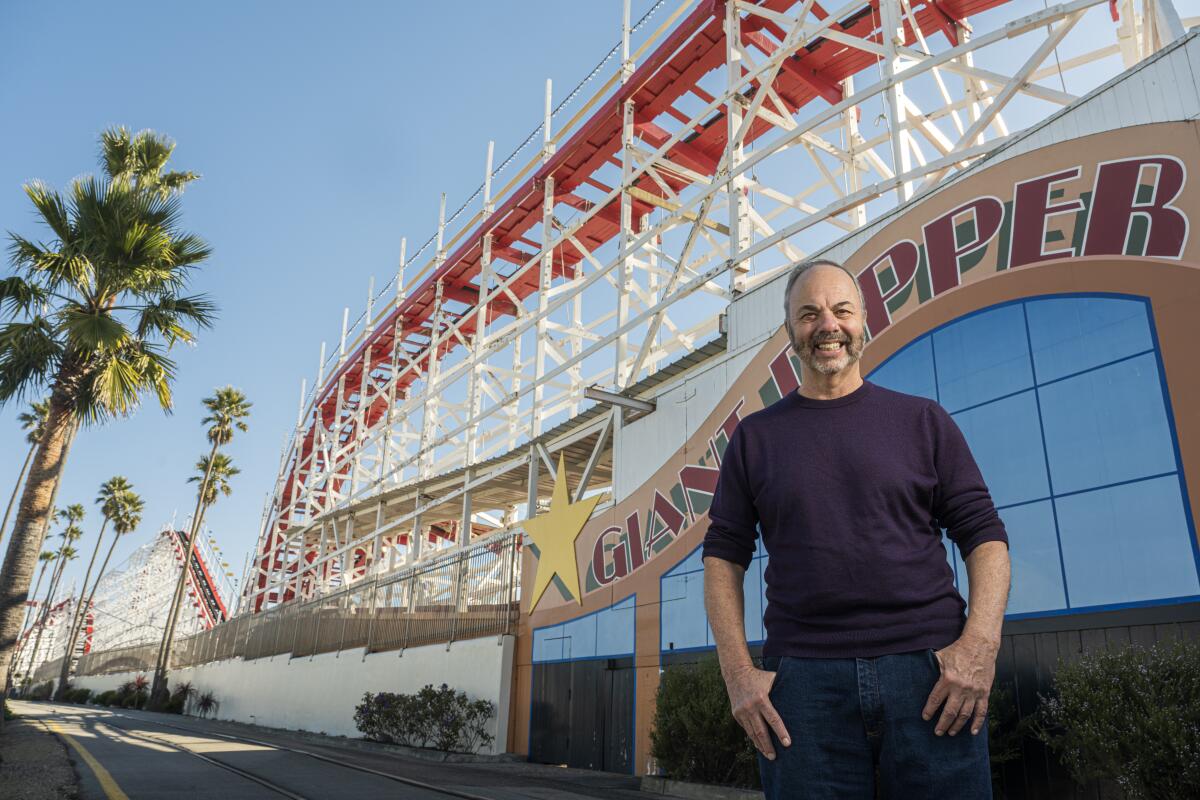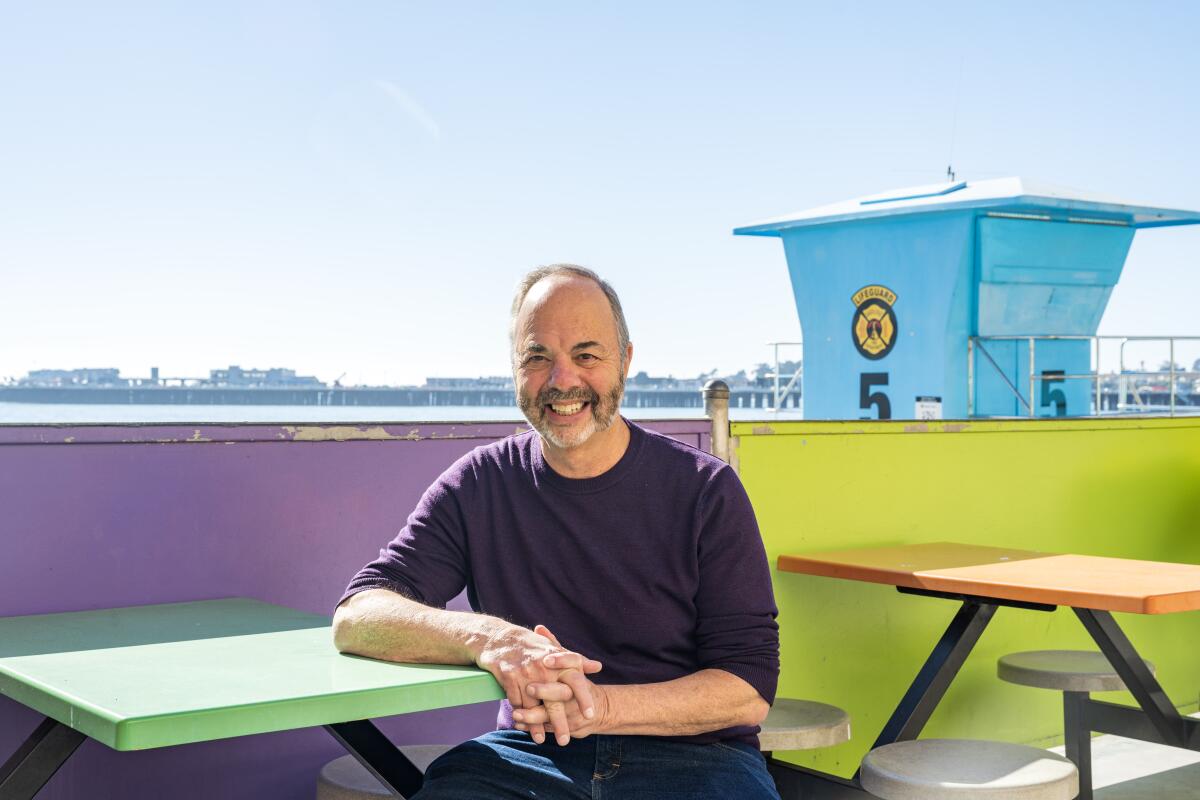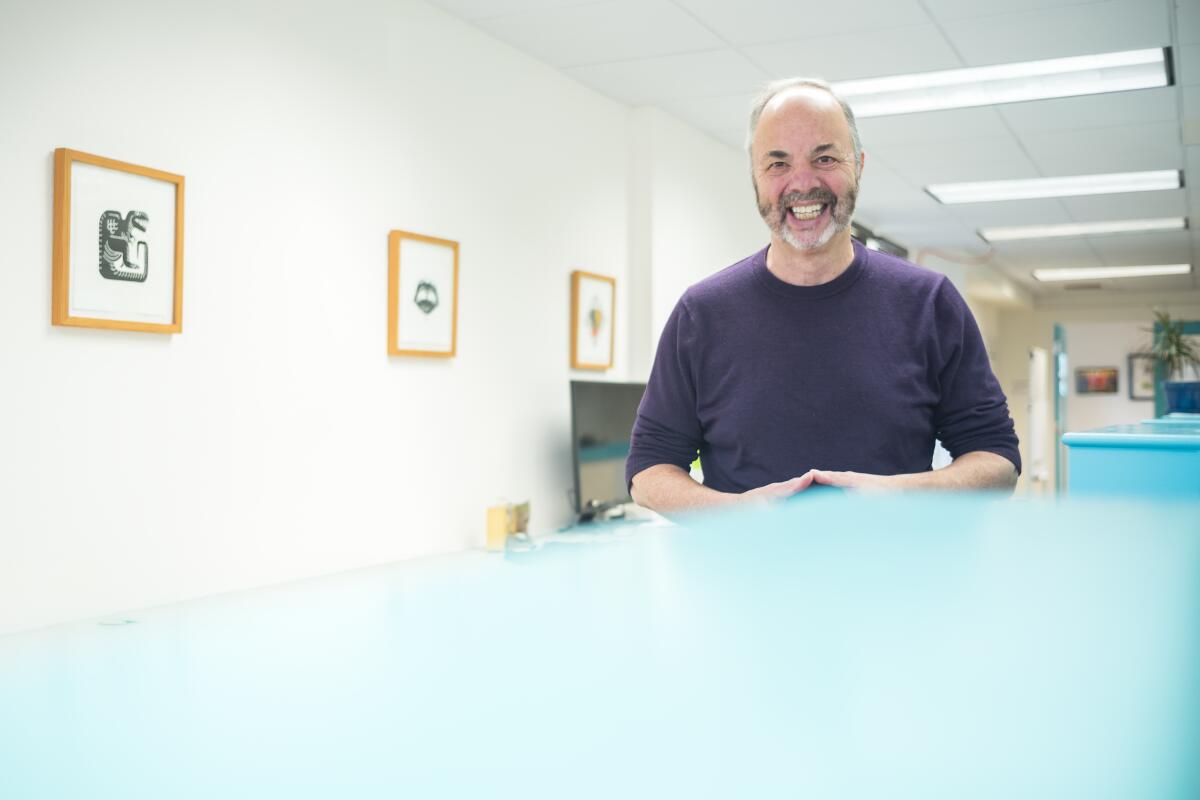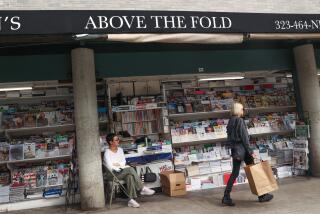Santa Cruz ânews desertâ? An industry guruâs digital startup challenges local rivals

SANTA CRUZ â Over many years as a leading media analyst, Ken Doctor spoke out repeatedly about the disintegrating American newspaper business. The nationâs top media outlets quoted him exhaustively on shrinking newsrooms and communities left bereft of timely information.
So when Doctor announced two years ago that he would leave the commentatorâs ivory tower to start his own website â dedicated to providing âa wide-reaching new model for local newsâ â the news industry took notice.
Practice, it turns out, is harder than preaching.
In the first year after its founding, Doctor and his Lookout Santa Cruz website watched three top editors and the chief revenue officer bail out to other cities; endured an exodus of reporters, some complaining the upstart had not lived up to its lofty goals; and absorbed a broadside from a rival local publisher who invited Doctor to leave town in favor of one of 188 U.S. counties without any newspaper.

Many seven-day workweeks and nights of fitful sleep ensued, challenges even more difficult than Doctor acknowledged in his columns about the startup.
But the prognosticator-turned-practitioner persisted through what he described as the most difficult challenge of his nearly half-century in the news business. Now, after more than a second full year, Doctor says his fledgling company is on track to make a profit in 2023. If that trend holds, he hopes that his parent company, Lookout Local, can open another website by early 2024, probably in another California city. That would mark a small reversal of fortune in a nation of expanding ânews deserts,â communities lacking adequate sources for local news.
âI just want people to know, more than anything else, that community journalism can be done and that it can be paid for,â Doctor said. âIt requires the proper investment from the start and a really good journalistic product. But itâs no longer a question. It can be done.â
President Biden arrived in California on Thursday and joined Gov. Gavin Newsom and U.S. Sen.
Beginning with a base of philanthropic support, Lookout is using a combination of advertiser and online subscription revenue in an attempt to create a sustainable revenue stream. As an all-digital outlet, it jettisons the enormous printing and distribution costs of newspapers.
With a news staff of 10, Lookout employs more journalists than the cityâs 167-year-old daily newspaper, the Sentinel, which has an editorial staff of seven. Also competing for local readers are the alternative weekly Good Times and another digital outlet, Santacruzlocal.org, started by two Sentinel alums.
During this winterâs fierce storms â what one reader called the âStormpocalypseâ â Lookout delivered a more consistent stream of news and analysis of the damage and recovery efforts than any of the other outlets, attracting the most readers in its history. Close observers of the news here say the presence of the upstart has pushed all the outlets in town to up their journalistic games.
âWe are not back to where we were 20 years ago. And it can always get better,â said Ryan Coonerty, a lecturer in the politics and legal studies department at UC Santa Cruz. âBut [Lookout] has certainly improved things. Iâm glad weâre a little pilot program for local news here.â

Doctorâs experiment has drawn considerable attention because of his high profile among his news industry peers, his widely read column for Harvard Universityâs Nieman Journalism Lab and the size of the challenge facing local news publishers.
Dozens of counties nationally have no local news outlet at all or have âghost newspapersâ that have slashed staff to almost nothing. The total number of U.S. newspaper editorial employees declined from more than 74,000 in 2006 to fewer than 31,000 in 2020, the Pew Research Center reported.
The Santa Cruz Sentinel has not been spared. From a peak of about 40 newsroom employees about two decades ago, the paper now has just seven covering a county of 275,000 people.
âKen Doctor seems to want to change the subject. Rather than provide real transparency about the actual performance of his website, he instead disparages an honest to goodness daily newspaper,â Guy Gilmore, chief operating officer of MediaNews Group, which owns the Sentinel, and Tribune Publishing, said in a statement. âWebsites donât fare well in competition with printed daily newspapers, so Doctor is misguided in his obsession with the Santa Cruz Sentinel.
âThe reality is that his website is good for the community because thereâs no such thing as too much local news. That said, more focus on his own operation, and fewer insults would be a more productive approach. Victory by insult is a losing strategy.â
Doctor denied any âinsultsâ or âobsessionâ and said he is focused on covering the news.
And thereâs plenty to cover. Santa Cruz was recently named the second least affordable community for rental housing in America, trailing only San Francisco. Homelessness and fentanyl overdoses have become chronic, and recent rainstorms made the county an epicenter of the stateâs flood disaster.
Doctor had been watching the challenges accumulate from his home in Aptos, the coastal community east of Santa Cruz. He had been a student in the 1970s at UC Santa Cruz and returned a dozen years ago after a newspaper career that took him from an alternative weekly in Oregon, to the now-defunct Knight Ridder chain in places like St. Paul, Minn.
The media commentator told the New York Times he lived in a âworsening news desertâ and that Lookout would provide an oasis. But those claims infuriated some of those already delivering news at the north end of Monterey Bay.
Dan Pulcrano, executive editor and publisher of Good Times, wrote an essay that not only invited Doctor to take Lookout elsewhere but said that calling Santa Cruz a news desert was âa bald-faced lieâ and an insult to âthe amazing work being done by local writers and editors.â
Doctor, 73, said the reduction in journalistic boots on the ground cannot be denied. âThis region lacked the number of journalists it needed to thoroughly inform the public,â he wrote in one of his essays.
Lookout now employs five reporters, three editors, a food columnist and a photographer to cover a wide mix of stories, including the shutdown of a homeless encampment on the Benchlands, near the San Lorenzo River, one womanâs account of her unhappy stays in the local jail and the 42nd Santa Cruz Clam Chowder Cook-Off.
âOn what I would call news, Lookout SC is the go-to media in Santa Cruz these days,â said Mayor Fred Keeley, a former state Assembly member. He credited Lookout with offering far more comprehensive coverage of the November election than the Sentinel.
Lookout achieved immediate credibility with many local readers by hiring Wallace Baine, a reporter and columnist with three decades of experience at the Sentinel and Good Times. A longtime savant of the arts and culture scene, Baine also writes about development and other topics.
âHe really understands what makes the community tick,â said Bill Maxfield, principal at a local public relations firm. âThere are people who will go wherever Wallace goes.â
Another Lookout reporter, Mark Conley, has taken on sobering topics like the potential threat of agricultural pesticides use near schools. But recognizing that many locals arenât attuned to government, Conley has also profiled Santa Cruzâs surf culture and âthose whose pulse beats in rhythm with the ocean.â
Said Conley: âIf we donât connect Lookout to the people and stories that make this place unique, thatâs a core segment of the countyâs audience weâre missing.â
Martha Mendoza, a Santa Cruzan and Associated Press journalist who has won two Pulitzer Prizes, said she appreciates Lookoutâs âhustleâ but sees an emphasis on lighter features. âSometimes I breeze through their app,â Mendoza said, âand I see, hereâs another food review; hereâs another restaurant opening. But, like, whereâs the news?â
Royal Calkins, an award-winning reporter in his days with the Sentinel and other papers, recalls when he brought Lookout his story on alleged chronic understaffing at a nursing home chain with a 92-bed facility in Santa Cruz. A Lookout editor declined to publish the story because the outlet didnât have enough reporters for the inevitable follow-up coverage. The response felt âtimid,â Calkins said, âand it made me a little sad.â
Conley, who previously served as an editor, confirmed Calkinsâ account. But Conley said the current Lookout is a ânight and dayâ ahead of where it was a year ago in its capacity to handle more stories, particularly since Doctor assumed editorial oversight early last spring.
Media veterans know that deeper coverage takes time and often comes from reporters who have been tilling beats for years. But turnover during Lookoutâs first year was high. Only two staffers from the October 2020 startup remain.
Doctor feuded with the first two executive editors he hired to run Lookout, according to several former employees, who declined to be named to preserve relationships with the founder and editors.
âIt was very top down, not collaborative,â said one of the sources. âHe only trusted his own decisions.â
Lookoutâs first executive editor, Chris Fusco, and its second, Dan Evans, both left in less than eight months, taking jobs at newspapers in Houston and the Napa Valley, respectively. Both declined to comment on their time at the Santa Cruz startup, as did the siteâs first managing editor, who also departed after less than a year in that job.
Half a dozen other former employees (most paid $65,000 to $70,000 a year) also described a tense and unhappy environment during Lookoutâs first year. They worked mostly at home because of the COVID-19 pandemic while fielding what they considered shifting and sometimes impossible demands.
âIt ended up as a very disappointing and demoralizing experience,â said one reporter, who asked not be named to avoid alienating Doctor.
Doctor attributed the departures largely to the isolation of COVID-19 and the âgreat resignationâ that hit some parts of the economy. In retrospect, it might have been best to delay the launch, Doctor said, adding: âThe stress of trying to put together a team and culture is just really hard.â
In October, he hired Tamsin McMahon â a former West Coast correspondent for Canadaâs national newspaper, the Globe and Mail â as Lookoutâs managing editor. He calls the newcomer a âreally good partnerâ who has âexceeded my expectations.â
Lookout bolsters its news offerings via partnerships with other outlets, including Kaiser Health News, CalMatters and the Los Angeles Times. Lookout also pays a licensing fee to The Times for access to its content management system.
Still, Lookoutâs richer mix of news and features has not been able to push its readership past the Sentinel, according to two web analytics firms, Similarweb and ComScore. The Sentinelâs average monthly visits were nearly four times higher than Lookoutâs in October, November and December, Similarweb found.
Lookout launched with about $2.5 million raised from the Knight Foundation, the Google News Innovation Challenge, the Silicon Valley Community Foundation and other donors. To sustain itself, it relies primarily on payments from readers and advertisers, an age-old combination.
The website employs a paywall, offering âmembershipsâ at $17 a month or $187 a year, with a recent discount to $99 for the first year. These online subscriptions totaled 1,200 early last year, according to two former employees.
Doctor will not discuss that number. He puts the total number of subscribers at 8,500, including thousands of student readers subsidized by the Google News Initiative and other donors.
The main vehicle for advertisers on the site is âbranded contentâ â with marketing âpartnersâ paying from $600 to $60,000 for such content as simple banner ads, ad packages, email blasts, Instagram reels and articles written by outside companies and organizations. The advertiser articles (labeled as such) have featured topics like a Victorian home converted to a rehab center for unhoused people and a state parks program that engraves messages on picnic tables.
Gannett and GateHouse will merge into the largest U.S. newspaper company, but its future looks anything but certain.
Doctor called partnership revenue a âhome run.â
Doctorâs startup has other competition. In 2019, two former Sentinel journalists launched SantaCruzLocal.org. Kara Meyberg Guzman and Stephen Baxter aim for deeper looks at government and social issues and offer Spanish-language coverage, winning praise from many locals for their work.
âI thought, âWhy donât they team up?ââ said Mendoza, the Pulitzer winner. âThere are probably only nine reporters in this whole town. So itâs better if any two of them arenât competing for the same story.â
While Doctor said he asked Guzman to come on as a reporter, she believed her experience in the community warranted a more substantial role. The two couldnât agree on a collaboration.
Doctor acknowledges the ride has been rockier than he imagined. He has written about commiserating about âendless lists of to-dosâ and restless nights with the operators of other digital startups, like the Long Beach Post and Baltimore Banner. It felt like a relief, before the recent storms, to ease back to âmore normal 55-hour weeks.â
âYou feel the pressure of time. You feel the pressure of money,â Doctor said. âYou only have a certain amount of time to make things work.â
Doctor remains hopeful about reaching profitability this year and opening a second Lookout, though the threat of an economic downturn could set back those plans. He said itâs unclear where that might be, though former co-workers said Carmel and San Luis Obispo had been on the table.
At Lookoutâs launch, Doctor imagined something like a âSoaring â20sâ for local news companies. Though sobered by some of the obstacles, Doctor said heâs mostly âamazedâ at how far Lookout has come.
âWeâre not just talking on some speculative basis about whatâs possible,â he said. âWeâre doing it, while offering high-quality, nonpartisan local news.â
More to Read
Updates
2:39 p.m. Feb. 5, 2023: This article was updated to include more detailed online readership data, and to include a response from Doctor to MediaNews.
7:58 a.m. Feb. 5, 2023: This article has been updated with a comment from Guy Gilmore, chief operating officer of MediaNews Group, which owns the Santa Cruz Sentinel, and Tribune Publishing.
Sign up for Essential California
The most important California stories and recommendations in your inbox every morning.
You may occasionally receive promotional content from the Los Angeles Times.













